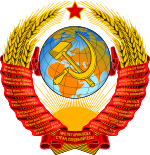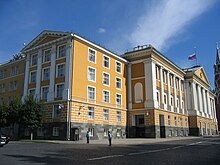This article needs additional citations for verification. (December 2020) |
Soviet of Nationalities Совет Национальностей | |
|---|---|
| Legislative body in the Soviet Union | |
 | |
| Type | |
| Type | |
| History | |
| Established | 1938 |
| Disbanded | 21 October 1991 |
| Preceded by | Congress of Soviets |
| Succeeded by | Soviet of the Republics (in USSR) Soviet of Nationalities (in Russia) CIS Interparliamentary Assembly |
| Leadership | |
Rafik Nishanov (last) | |
| Structure | |
 | |
Political groups | Composition after the 1984 election: Communist Party of the Soviet Union (521) Independents (229) |
| Elections | |
| Direct elections (until 1989) Elected by the Congress of People's Deputies of the USSR (from 1989) | |
Last election | 1984 Soviet Union legislative election |
| Meeting place | |
 | |
| Kremlin Presidium, Moscow Kremlin | |
| Politics of the Soviet Union |
|---|
 |
|
|
The Soviet of Nationalities[a] was the upper chamber of the Supreme Soviet of the Union of Soviet Socialist Republics, elected on the basis of universal, equal and direct suffrage in accordance with the principles of Soviet democracy. Until democratization in the late-1980s, however, only a single candidate nominated by the Communist Party of the Soviet Union was permitted to stand for election in each constituency. It was briefly succeeded by the Soviet of the Republics from October to December 1991. As opposed to the Soviet of the Union, the Soviet of Nationalities was composed of the nationalities of the Soviet Union, which in turn followed administrative division rather than being a representation of ethnic groups.
Cite error: There are <ref group=lower-alpha> tags or {{efn}} templates on this page, but the references will not show without a {{reflist|group=lower-alpha}} template or {{notelist}} template (see the help page).